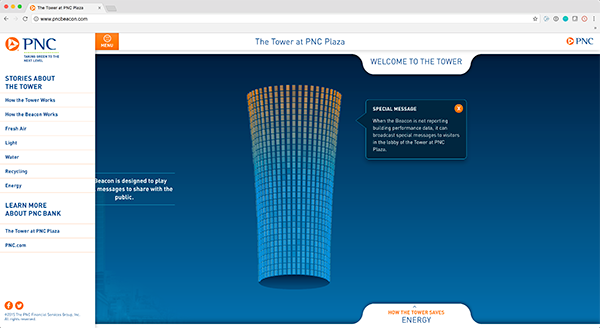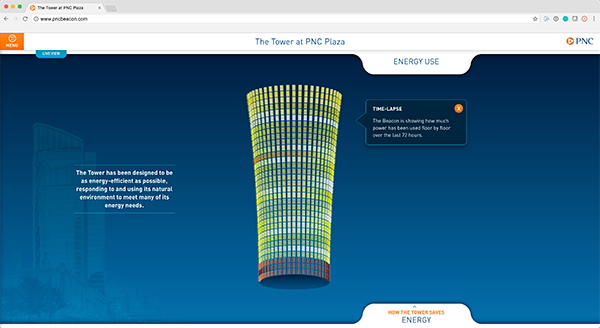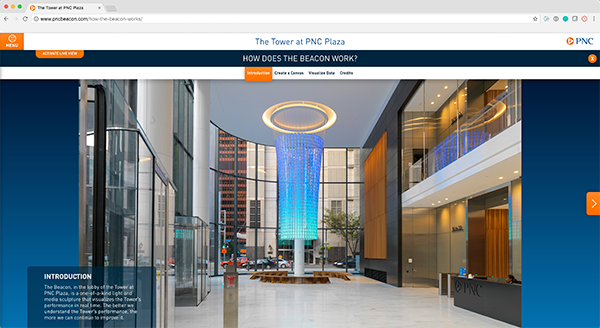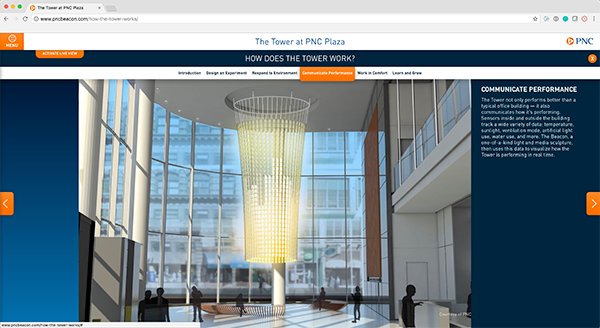Creator of RubyApps and RubyLaw, Content Lifecycle Management (CLM) platforms that make creating, managing, delivering, and analyzing digital content easy and effective
The Beacon at The Tower at PNC Plaza: RubyContent-powered microsite
PNC, a leading financial institution, built a state-of-the-art, LEED Platinum-certified office tower in Pittsburgh. However, they needed a way to showcase their dedication to sustainability and the environment to building occupants and the community.

PNC was already on a track to green, sustainable operations when they upped their own ante, promising to strengthen their dedication to the environment through reducing energy consumption 20% by 2020. In furtherance of this goal, PNC ensured that its new office tower at PNC Plaza in Pittsburgh be designed and built with numerous innovative systems that automate energy-saving processes: its own water recycling system; weather-measuring systems, including temperature, humidity and sunlight; among others. All these systems allowed the building itself to regulate various conditions through automatic responses, including opening windows, or employing shading systems to trap or deter heat. The numerous energy-efficient systems incorporated into the building earned it the name the “world’s greenest skyrise.” The Tower achieved LEED Platinum certification, and boasts a 50% increase in general efficiency, with a 77% increase in water efficiency, over typical skyscrapers today.

However, none of these efficiencies of the Tower were visible to its tenants or passersby, so PNC engaged ESI Design to create a way to showcase the Tower and its accomplishments. Because of the intricate and complex systems within the tower, the design needed to be impressive, interactive, but above all easily understood. ESI Design’s answer was “The Beacon”, a majestic, 24-foot-high fixture in the lobby of The Tower at PNC Plaza. The Beacon is comprised of 1,584 transparent liquid crystal polycarbonate panels backed with a grid of LED lights, which illustrates, in real-time, how the building is performing, by using light and sound displays. The Beacon was impressive, but lacked a way for viewers to decode information and patterns. ESI sought a technology partner that was established enough to handle the massive amount of data that the Tower emitted, who could execute their high fidelity designs and translate to the web and who could understand back-end data, as well as respect front end design. RubensteinTech was the ideal candidate and was brought on to help create an interactive, content-managed website to convey to visitors the finer details of this building’s state-of-the-art design and sophisticated systems.

We collaborated with ESI to define the technology strategy and how to portray the massive amount of information. Because of the multitude of data sources that were present, the experience needed to be intuitive, dynamic and easily decoded—the experience had to seamlessly aggregate the data points into singular specs that were easily digestible by any viewer. Without this layer of information, the Beacon itself would only serve as a decorative entity, and not fully relay how environmentally-positive the Tower truly was.

Our solution was to create an interactive website that could be accessible from anywhere in the world, to broaden the impact of what PNC was doing. The main users would be visitors and tenants of the Tower, accessing the website via loaner tablets. This meant that the site had to mobile-optimized and highly responsive. The website integrates tightly with The Beacon and underlying building information systems to display a “Live Mode”, in which the The Beacon on the website closely mimics the live sculpture in real-time, coupled with related information to the current mode of display. The largest challenge with the site was the massive amount of information that the Tower relayed at any given moment. The information displayed brings more depth to the Beacon experience, decoding the light patterns as well as pulling in related information that adds context to the Tower’s accomplishments.
Roughly 900 people picked up a device and examined the beacon via the site and sessions averaged 4 minutes at a time. On average we pushed 720 updates through per hour for the Beacon’s Live View.